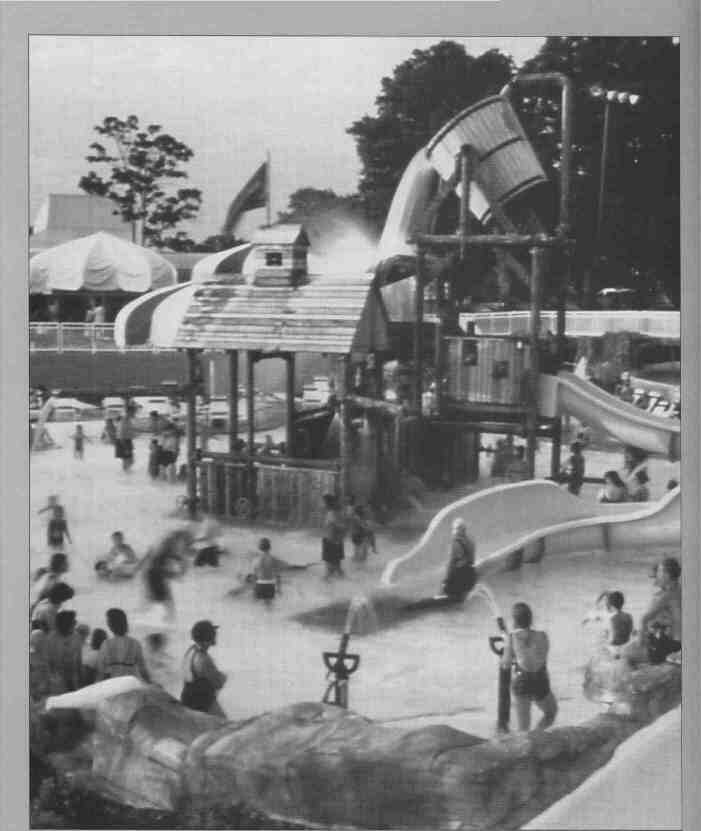


Bubble couches, indoor kayaking, high-tech lights and fountains, therapy pools. These are some of the features of aquatic facilities that will be hot, say the experts interviewed by IP&R for this special feature.
IP&R:What's next in aquatic facility design? What are you seeing now in the facilities that you are designing and those you're watching around the country?
Michael T Williams Williams Associates Architects, Ltd.: "Indoor multifaceted aquatics is hot! Multi-level pool layout combined with glass-walled pools, rope swings into the water, therapy pools, swim under the waterfall and wind up outdoors, rapids, river rides, indoor kayak rides, underwater hockey, obstacle water courses, Olympic fountain features in a park setting."
Jack Barclay, Barclay & Associates: "What we're seeing is that there seems to be two areas. One is the small children. They need something more than small pools of water. They want a lot of water toys in them. For the older kids, they need a challenge, slides are not enough. They're nice, but they're getting tired. Some districts want to go back to diving boards, jumping and doing flips, It's a liability again, they can hurt themselves, but this is what they want. Something more challenging for older kids."
Reed Vorhees, Sverdrup CRSS: "People are asking for things that are unfamiliar and creative. A lot of technical advances in fountains, high-tech valves and nozzles. Laminar flow water, Disney creativity. For example, taking a water jet and making it look like a glass rod. Water features that create jets and fountains, interactive things for people. They can shoot a bar of water from one hole to the other; little golf balls of water shoot out of the water and kids can try to grab them."
IP&R: What's next for rejuvenating older pools? What are you designing to breathe life into existing pools, so they become more marketable facilities?
Jack Barclay Barclay & Associates: "More shade areas and picnic areas where the family can come out and picnic at. This is nothing really new, but there's more emphasis on the family. Actually, right now, 75 percent of our work is renovation. One project is a pool that is 25 years old. A builder put this pool in for a subdivision and it became so run down he couldn't handle it, so they gave it to the village. We did a study on it and found that the filtration system has deteriorated so bad that it has to be replaced. As with any older pool, it must be made accessible to ADA standards."
"We've had a lot of interest in upgrading old pools. The agency can't afford to get into waterparks, yet they want to upgrade what they have. We're doing two upgrades right now, a filtration system that we put it 30 years ago, upgrade into a more modern easy-to-maintain system. This is really what we are going in water filtration."
January/February 2000 | 17
SPECIAL FOCUS
Michael T. Williams Williams Associates Architects, Ltd.: "Zero edge - walk in activity pools continue to be a primary new element. Drop slides are replacing diving boards and are used by a much wider ranging bather group. New dehumidification advances for indoor pools help make the environment far more pleasant and enjoyable. Where the terrain permits, multi-level pools are designed. Holograms increase the excitement of enclosed slides. The public delights in shooting fountains with spectacular light and music accompaniment. More features are being included in facilities that will satisfy the rapidly increasing senior population. Detached children's water playgrounds are extremely popular in independent park settings where there are no bathhouse or guard requirements. Monitors can observe when water features are on, and those features become a dry playground when the water is off."
Reed Vorhees, Sverdrup CRSS: "We've taken a competition pool and added a leisure component. It's also a trick so they look fresh, people will get tired of a leisure pool, or planning for expansion or change of amenities is important, too. For a couple of projects now we're reusing the guts of them and going from old community pools to more leisure, recreational pools. Water temperature is an issue. Kids that are playing in the pools like warmer water and swimmers want it cold. People want to reuse what they have, but sometimes it really tough to work with existing pieces.
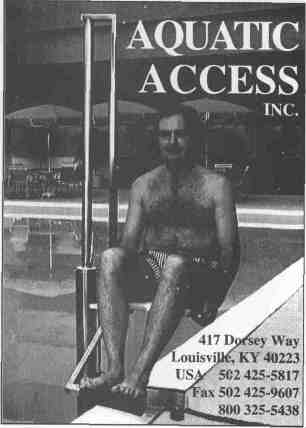
IP&R:Tell us about one of your current or recent aquatic facility design or renovation projects for a park district.
Michael T. Williams Williams Associates Architects, Ltd.: "The Palatine Park District's Community Park Family Aquatic Center was completed in March of 1999. It is a newly constructed 1,300-bather capacity facility with numerous amenities including an activity pool with a 'funbrella' in the water, a tot pool with a kiddie slide and waterfall, a six-lane lap pool, a plunge pool with one enclosed slide and one flume slide, wet and dry sand play areas, shaded structures with misters on the lawn area, a lawn area for sunbathers, a concession building currently rented out and under private management, a concession deck, and a new bathhouse. The project cost $4,155,000 was under the original budget and the facility was completed on schedule."
Jack Barclay Barclay 6- Associates: "The board of commissioners of the Itasca Park District awarded a contract to Paris Contracting Company to replace the original children's wading pool constructed 28 years ago. Funding for the project was a joint effort of the Itasca Park District and the State of Illinois Department of Conservation, Division of Grant Administration. The new 4,000-square-foot pool will have a 0" to 18" depth and a tropical theme according to director Randy Schawel. Construction is underway and is scheduled to be completed by May 2000 at a cost of approximately $475,000."
Reed Vorhees Sverdrup Facilities: "We did an outdoor facility in St. Louis, did a lot of level changes between the bodies of water and allowed the water to flow from one to another and it was a more interactive experience. The City of Kirkwood got together with two other cities (Glendale and Oakland) and built it as a team. Kirkwood talked to several cities and these were the ones that responded; they are much smaller and do not have resources and land for such a facility. Kirkwood provided the land, passed a sales tax in their community to help pay for it, Glendale did too. Oakland contributes out of general
18 | Illinois Parks and Recreation
WHAT'S NEXT?
revenue funds. They won an award locally for partnering.
"It has a 25-yard by 25-meter competition pool with two diving boards; an active leisure pool that has a large custom SCS unit like a big playground structure that sits in the water. Water goes up through tubing and all sorts of valves and nozzles with waterfalls and a tumble bucket on top that holds 400 gallons and then tips over and hits the roof of the structure and shoots out and lands on everybody. Then there's a more passive pool, fairly shallow, at a different level and a 750-foot lazy river.
"The entire facility is very compact, on 3 1/2 to 4 acres and that was a challenge in itself. It has a few play features and some jets, a bubble couch: a kind of form on the edge of a pool, a long thing that people can lay down in and experience intense bubbles, like a hard-boiled egg. We wanted to stair-step the pools and get some different elevations, we carved this into the hillside, a lot of artificial rock to make it appear as though its carved into the hillside."
IP&R: How did the community decide what will be built?
Reed Vorhees,
Sverdrup Facilities: "We went to each city individually
and held a town meeting presentation where we
showed them different features that we've seen around
the country in aquatic facilities, familiarized each city
with those features. Then we listed those
features on a flip chart and gave everyone 3
dots or 5 dots and let them put a dot on the
feature they liked the most so we could rate
them. It helped dictate what the people
wanted, some of the more common
elements. It definitely gave us a pulse for
what they were looking for."
IP&R:Is the aquatic facility industry in a boom, plateau or a slowdown period?
Michael T. Williams
Williams Associates Architects, Ltd.: There has
been a bit of a slowdown with outdoor
aquatic development that we have experienced from 1985 to 1995, but there is still a
great deal of activity. We are currently
working on six facilities, four of which will
be subject to March 2000 referenda. Indoor
pools are now the "next wave" of interest.
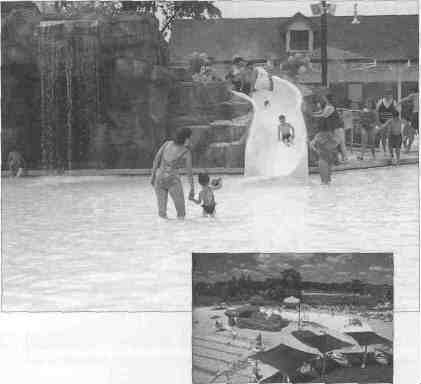
Photo above: Designed by Williams Associates, Ltd., the Palatine Park District's Community Park Family Aquatic Center, completed in March 1999, is a 1,300-botfier capacity facility with amenities such as an activity pool with a 'funbrella' in the water, a tot pool with a kiddie slide and waterfall.
Below: Rendering by Barclay & Associates of the Itasca Park District's wading pool and balhhouse, scheduled to open in the spring of 2000.
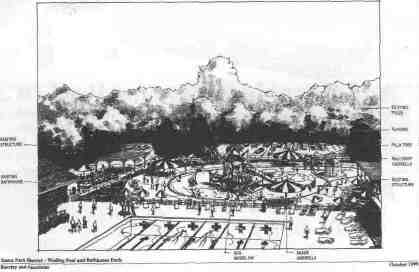
January/February 2000 | 19
WHAT'S NEXT?
We are involved with eight indoor aquatic projects and interest is growing month by month.
Reed Vorhees
Sverdrup CRSS: Personally, I think it's in
a boom and I say that because there are
so many facilities that are starting to date
themselves, old competitive pools. In our
minds it's evolutionary; it's a natural
process of technology and understanding
of how people recreate and behave. We
grew up in competition pools and now
people are understanding that the
recreation and the fun are really driving
people, and adapting the design to those
need.
IP&R: What do you think are the hottest issues for park district aquatic facility design or renovations?
Jack Barclay
Barclay & Associates: "Seniors are a bigger population.
We're doing a pool addition for Glen Ellyn Park
District where they have a beautiful water park but
really no area where seniors could come in and do
their laps or just walk in water that's between 4 and 5
feet deep. They are adding a pool, basically for
seniors. It's also designed for swim teams and meets."
Reed Vorhees
Sverdrup CRSS: "Issues that are interesting to me are
how the facilities are managed. A lot are managed by
companies, some are managed by the community
themselves and a lot from group to group.
"How tall do you have to be to use the water slide? How do they handle lightening situations? What if a child goes to the bathroom in the pool? There doesn't seem to be a standard for these issues. Some states have regulations and even the health codes are not up to speed on these facilities."
Michael T. Williams
Williams Associates Architects, Ltd: "New cooperative
ventures with fitness, wellness, hospitals, local donors
and private sector developers are offering park districts
an opportunity for aquatics, especially indoor, that
didn't exist a decade ago. Creative funding and
partnering are taking hold."
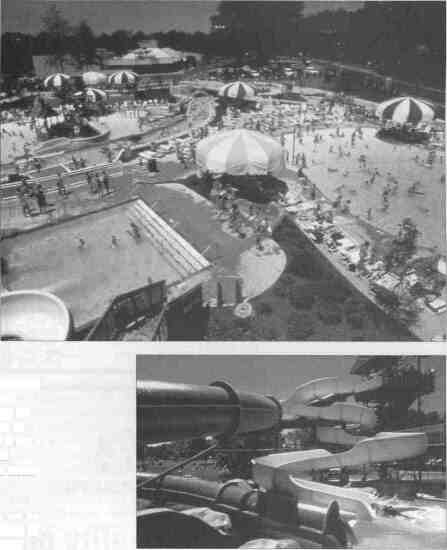
Photos above: The Kirkwood
(Mo.) Aquatic Complex is very compact, on about four acres, which was a challenge in itself to include all the desired features. Designers Sverdrup CRSS stair-stepped the pools to get some different elevations and used a lot of artificial rock to make it appear as though the pool is carved into the hillside.
JACK BARCLAY
is president and owner of Barclay & Associates, established in 1952 with a focus on
public aquatic facilities since 1958. The firm has worked for more than 30 park
districts in the stale of Illinois. Barclay & Associates is located in Oak Park, III.,
708.383-8050.
REED VOORHEES
is an architect and senior designer for Sverdrup CRSS, a St. Louis-based architectural
engineering and construction firm with speciality in sports and recreation, including
aquatics and community centers.
MICHAEL T. WILLIAMS
is principal of Williams Development, Ltd., in Wheaton, III. Williams formed the
company in 1994 after spending 20 years as co-principal of another firm and has
since completed more than 80 aquatic and recreational projects. 630.221.1212,
waa@waa-architects.com
January/February 2000 | 21